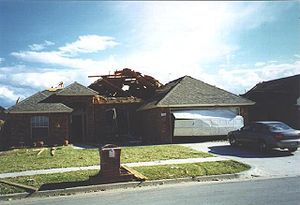 |
| Image via Wikipedia |
If violent weather has caused damage to your property, you may be able deduct a part of the cost of the damage from your taxes, if the event was a federally-declared disaster.
You are generally eligible to deduct losses that result from federally-declared disasters. This can include, here in the Midwest, such mundane items like floods or tornados, plus the occasional derecho. In California, it might include (per Jimmy Buffett) riots, fires, mudslides and sushi in the mall*. Remember that the deduction amount is limited by any amount that you recover by way of insurance.
* Riots and sushi may not actually included. Consider it poetic license.
If you’re in a presidentially-declared disaster area, there are special rules that apply to you. You are eligible to deduct those losses that occurred in the specific event in a current tax year on either your current or prior year tax return, whichever is more beneficial to you. If you’ve already filed the return for the prior year you can amend it with the casualty loss information to get a refund. For more information, go to www.fema.gov/disasters.
When a qualified federally-declared disaster has impacted you, you may have more options available to you. For more information on types of losses, see IRS Pub 547 for detailed definitions of the casualty loss (within the state of a declared disaster), disaster loss (within the county of a declared disaster), and qualified disaster loss (certain specified disasters). For these qualified disaster losses, you are allowed to itemize the loss deduction without regard to other itemized deductions. The 10% floor limitation mentioned below does not apply, but the disregarded “first amount” is $500 instead of $100.
If you have otherwise experienced a loss due to damage from one of these natural disasters, this is classified by the IRS as a casualty loss. Casualty losses are deducted using IRS Form 4684. Deductible losses are limited in two ways for individuals: the first $100 is not deductible; above that amount, your deductible loss is limited to the amount that is greater than 10% of your Adjusted Gross Income (AGI). You must itemize deductions in order to deduct a casualty loss as an individual.
Losses from other events that are not federally-declared disasters are not eligible for a deduction during tax years 2018 through 2025. We’ll have to wait and see if the deduction is restored after 2025.
For a business, the limits mentioned above are not in affect, and they do not need to be claimed as itemized deductions.


 Sterling Raskie, MSFS, CFP®, ChFC®
Sterling Raskie, MSFS, CFP®, ChFC® The latest in our Owner’s Manual series, A 401(k) Owner’s Manual, was published in January 2020 and is available on
The latest in our Owner’s Manual series, A 401(k) Owner’s Manual, was published in January 2020 and is available on  A Medicare Owner’s Manual, is updated with 2020 facts and figures. This manual is available on
A Medicare Owner’s Manual, is updated with 2020 facts and figures. This manual is available on  Social Security for the Suddenly Single can be found on Amazon at
Social Security for the Suddenly Single can be found on Amazon at  Sterling’s first book, Lose Weight Save Money, can be
Sterling’s first book, Lose Weight Save Money, can be  An IRA Owner’s Manual, 2nd Edition is available for purchase on Amazon. Click the link to choose the
An IRA Owner’s Manual, 2nd Edition is available for purchase on Amazon. Click the link to choose the  Jim’s book – A Social Security Owner’s Manual, is now available on Amazon. Click this link for the
Jim’s book – A Social Security Owner’s Manual, is now available on Amazon. Click this link for the  And if you’ve come here to learn about queuing waterfowl, I apologize for the confusion. You may want to discuss your question with Lester, my loyal watchduck and self-proclaimed “advisor’s advisor”.
And if you’ve come here to learn about queuing waterfowl, I apologize for the confusion. You may want to discuss your question with Lester, my loyal watchduck and self-proclaimed “advisor’s advisor”.